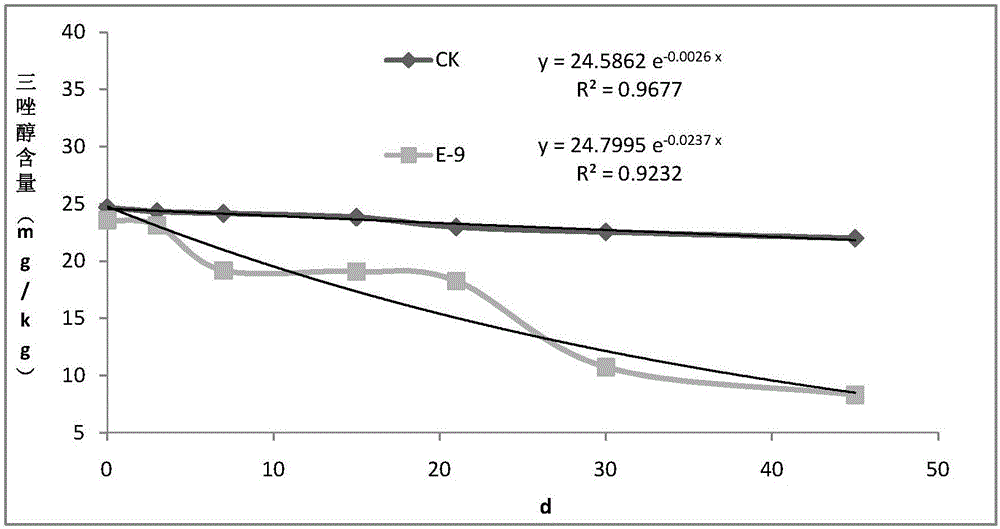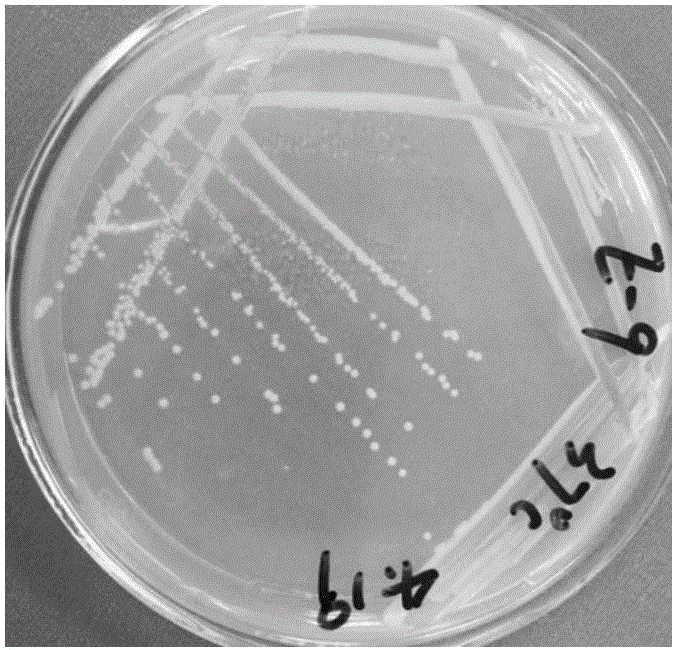Method for degrading triadimenol in soil by virtue of novel microbial strain
A technology of triadimenol and bacterial strains, which is applied in the field of microbial applications, can solve problems such as triadimenol residues, and achieve the effect of wide application prospects
- Summary
- Abstract
- Description
- Claims
- Application Information
AI Technical Summary
Problems solved by technology
Method used
Image
Examples
Embodiment 1
[0036] Embodiment 1: the screening of new bacterial strain E-9
[0037] The present invention collects the activated sludge of the aeration tank from a pesticide factory in Zhejiang Province, and rapidly screens bacterial species from it within 24 hours; the specific method of screening is: take 10g of activated sludge, place it in 100mL enrichment medium, and simultaneously Add 0.1mL of 100g / L triadimenol original drug to make the final concentration 100mg / L, and at 30℃, 180r.min -1 Culture on a shaking table, inoculate once every 7 days thereafter, inoculate into fresh medium with 10% inoculum, and gradually increase the concentration of the tested pesticide to 600 mg / L with 100 mg / L as an increase unit. Then the culture solution was added to the inorganic salt medium with the tested pesticide triadimenol (600mg / L) as the only carbon source for acclimatization 2-5 times, 7 days each time, and finally separated on the ordinary medium by smearing. Select colonies with fast grow...
Embodiment 2
[0041] Embodiment 2: Identification of new bacterial strain E-9
[0042] For the strain E-9 screened in Example 1, the strain collection center of Wuhan University was entrusted with the measurement and analysis of the 16SrRNA gene sequence of the microbial strain, the observation of the morphology of the strain, and the identification of the physiological and biochemical characteristics of the microbial strain. According to the above test results, strain E-9 was identified as Achromobacterxylosoxidans, Gram-negative, and this strain was preserved in Wuhan China Type Culture Collection Center on June 24, 2016. The number is CCTCCNO:M2016348.
[0043] Strain E-9CCTCC NO:M 2016348 16S rRNA gene sequence:
[0044] GGCACGATCTACGTGGTATCGCCCCCCTTGCGGTTAGGCTAACTACTTCTGGTAAAACCCACTCCCATGGTGTGACGGGCGGTGTGTACAAGACCCGGGAACGTATTCACCGCGACATGCTGATCCGCGATTACTAGCGATTCCGACTTCACGCAGTCGAGTTGCAGACTGCGATCCGGACTACGATCGGGTTTCTGGGATTGGCTCCCCCTCGCGGGTTGGCGACCCTCTGTCCCGACCATTGTATGACGTGTGAAGCCCTACCCATA...
Embodiment 3
[0052] Embodiment 3: Utilize strain E-9 to degrade the method 1 of triadimenol in soil
[0053] Follow these steps:
[0054] (1) Strain activation medium: yeast powder 5.0g, peptone 10.0g, NaCl 5.0g, distilled water 1000mL, pH7.0. After being sterilized, it is ready for use;
[0055] (2) Strain fermentation medium: (NH 4 ) 2 SO 4 1.0g, FeSO 4 ·7H 2 O 0.005g, CaSO 4 0.08g, Na 2 MoO 4 2H 2 O 0.0033g, MgSO 4 0.2g, K 2 HPO 4 1.0g, KH 2 PO 4 1.0g, 3.0g sucrose, 0.5g peptone, 1000mL distilled water, pH 7.0. After being sterilized, it is ready for use;
[0056] (3) Preparation of seed liquid: Pick the preserved strain E-9CCTCC NO:M 2016348 of 1-ring Achromobacterxylosoxidans slant, insert it into the medium of step (1), and put it under the conditions of 30°C and 180rpm After 24 hours of shaking culture, the seed liquid was obtained and set aside;
[0057] (4) Preparation of the degrading bacterial agent: insert the seed solution of step (3) into the medium of ...
PUM
 Login to View More
Login to View More Abstract
Description
Claims
Application Information
 Login to View More
Login to View More - Generate Ideas
- Intellectual Property
- Life Sciences
- Materials
- Tech Scout
- Unparalleled Data Quality
- Higher Quality Content
- 60% Fewer Hallucinations
Browse by: Latest US Patents, China's latest patents, Technical Efficacy Thesaurus, Application Domain, Technology Topic, Popular Technical Reports.
© 2025 PatSnap. All rights reserved.Legal|Privacy policy|Modern Slavery Act Transparency Statement|Sitemap|About US| Contact US: help@patsnap.com



